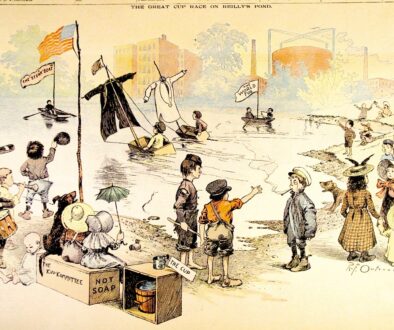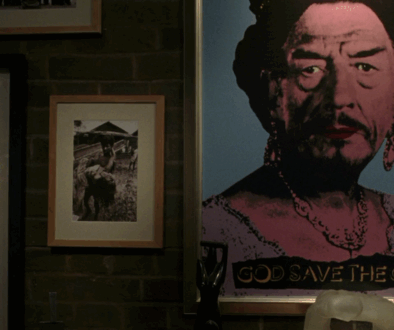“The Curse,” however, was not an uncontroversial story. Indeed, it generated so much response that the letter pages of both Swamp Thing #45 and #46 were devoted entirely to letters regarding the story. For the most part, however, these letters were in favor of the story. The only outright critical letter in Swamp Thing #45 comes from a gentleman in (ironically) Northampton, Massachusetts, and complains that Moore repeats the phrase “hungry for the moon” too often, objects to the story’s generality in speaking for all women, and complains that the display of steak knives is unrealistic (“no market worth its liabilities would ever, ever, never-ever display its cutlery so dangerously”). Of these three complaints it is, in an idiosyncrasy typical of the sorts of comics readers who wrote in to DC letters pages in the 1980s, the steak knives that seem to be the biggest problem. Another letter, however, takes issue with the ending of the story, while still generally praising it.
 |
Figure 478: Phoebe lying dead under the howling moon.
(Written by Alan Moore, art by Steve Bissette and John
Totleben, from Swamp Thing #40, 1985) |
This sentiment is shared by one of the two letters presented in Swamp Thing #46. This letter, by Mindy Newell, takes up most of a page, and Moore offers an equally long response in the letter page. Newell’s objection is straightforward – that Moore’s decision to have Phoebe kill herself is a weak cop-out of an ending. Newell writes, “I also understand that you were trying to point out to our male audience that women don’t deserve to be treated in such a horrific manner… that you were striking a blow, not just for equal rights, but for equal understanding. But,” she continues, “how can there be equal understanding between partners when one of them lies dead under the howling moon?” She goes on to point out that Phoebe’s husband has almost certainly learned nothing from the incident. “My best guess,” she offers, “is that he will mourn for a time, but sooner or later the guilt he feels over Phoebe’s suicide will turn to callous anger… ‘Oh, well, she was always a bit loony anyway.’” Continuing her critique, she asks rhetorically, “why does Phoebe kill herself? You can beat around the bush all you want, but in the end she killed herself because she was born a woman. Great message, Alan,” she adds, dripping with sarcasm. (All of which said, Newell ends her letter by noting that she’ll be voting for the story in all the all the major awards, which provides needed context to her sharp criticism – criticism that Moore admits is “a valid reaction to the story” and taking the blame for any misinterpretations that the story leaves itself open to.)
 |
Figure 479: This is not the exclusive true face of womankind.
(Written by Alan Moore, art by Steve Bissette and John Totleben,
from Swamp Thing #40, 1985) |
When answering the letter expressing similar criticism in Swamp Thing #45, Karen Berger declared that “Phoebe killed herself because it was the only freedom she felt she had; one lone, suppressed, repressed, uninformed, isolated woman living in Nowhere, U.S.A., where women are generally more visibly persecuted than their educated, independent counterparts in the city. Phoebe’s choice of suicide may have been her only relief, sad and unfortunate as it was. It wasn’t in any way meant to imply or represent a statement or action for women as a whole.” Moore, in his typically lengthy reply, makes a similar observation, saying that the fact that Phoebe is “a furious and slavering werewolf should have been enough to tip off the reader that what we were dealing with here was simply one aspect of a woman and her nature rather than trying to imply that this howling and ultimately self-destructive monstrosity was in some way the exclusive true face of womankind.” In Moore’s view, the reason behind the suicide ending was that Swamp Thing’s audience is primarily made up of men, and “that a downbeat and pessimistic portrayal was more likely to stick in the mind and have repercussions.”
Put another way, then, Moore’s contention is that for a horror comic, an unsettling and not entirely satisfying ending is not merely appropriate, but largely preferable. And, as Moore puts it, “I wanted to suggest that the mistreatment of women either physically or psychologically was something that went back a long way, something that had almost become completely institutionalized as part of our social outlook. That, as I see it, is the curse, along with the adjacent Catch-22 that even when women can express their anger, they’re only allowed to do it in male terms, by which token they’ve already lost.” In this regard, Moore views Phoebe’s suicide as a deeply flawed solution that “preserved a certain integrity” in the character, inasmuch as her death is at least on her own terms. And this is certainly supported by the issue itself, where her death is described as “a poor kind of moonlight,” a description that at once grounds Phoebe’s actions in the larger werewolf mythology and emphasizes its inadequacy as a solution. (In truth nobody raises the most cutting objection to the resolution of “The Curse,” which is to ask why it is that the plight of the modern woman is squared away in a single issue while a story about underwater vampires that mostly serves to demonstrate why underwater vampires just aren’t that interesting is stretched out over two issues. Much of what Newell and others object to in “The Curse” could have been squared away if the issue did not have the lingering sense that the primary reason Phoebe flung herself at a display of cutlery was that she’d reached the end of page twenty.)
 |
Figure 480: Swamp Thing saves Superman from the Kryptonian
Bloodmorel. (Written by Alan Moore, art by Rick Veitch and
Al Williamson, from DC Comics Presents #85, 1985) |
What is not immediately obvious from Newell’s letter, however, is why it and Moore’s response are given the lion’s share of a letter column, and a letter column that is the second column devoted to the issue in question at that. The answer, although it’s not clearly acknowledged on the letter page, is that Mindy Newell is not a random reader, but another writer at DC Comics and a protege of Karen Berger’s who is perhaps best known for being the first ongoing female writer of Wonder Woman. Given Newell’s admission at the end of her letter that she considers the story tremendously praiseworthy, it is important not to overemphasize the degree to which the letter represents a feud within the DC stable, but it’s also worth noting that for the second story in a row, Moore found himself at odds with other parts of DC. To some extent, of course, this is the point of the “American Gothic” arc – an attempt to critique America. And it is not that Moore was falling out with DC, at least not yet. Indeed, he was still actively producing work for the company, including, the same month that “The Curse” came out, an issue of DC Comics Presents that had Superman and Swamp Thing meeting, with Swamp Thing saving Superman from a fatal Kryptonian fungal infection. But for all of this, the sense of an inevitable and perhaps unavoidable tension between Moore and his American publishers was rising.
 |
Figure 481: The Winchester Mystery House in San Jose, California,
constructed over the course of thirty-eight years under the
supervision of Sarah Winchester, widow of the famed gun magnate,
with the intent of warding off evil spirits. The mansion has around 160
rooms and numerous doors and staircases leading nowhere. |
This was not, however, because Moore was doing anything different than what he had been doing. Regardless of its success, it’s clear that with “The Curse” Moore returned to the approach he’d used in “The Nukeface Papers”: a heavily politicized horror in which whatever issues of the day Moore was passionate about were adapted into comic book monsters. Indeed, after its initial vampire two-parter, all of the stories within the arc are framed around clearly chosen political issues, which are paired with other classic horror monsters. “The Curse” was his engagement with feminism, and was followed immediately by another two-part story, this time matching up zombies with the history of racism and slavery in America. The result was not entirely successful – Moore flatly described it as ‘a failure” that “didn’t really work” because it “ended up not quite saying what I’d wanted to say,” which is on the whole a fair assessment. Moore’s claim that he sat down “to try to analyze what I’d done wrong and work out ways that I could avoid making that mistake again,” however, seems in many ways to implicate the technical aspects of Moore’s writing instead of putting the criticism where it belongs on this arc: on the fact that Moore, as an English writer whose only actual direct experience with the United States consists of a week-long trip to New York City and Vermont, neither of which, notably, are the Louisiana Bayou, is perhaps not in a good position to cast bland platitudes about how the solution to the long and awful legacy of American slavery is to “break this terrible cycle” of violence so that everyone can (presumably) just get along. Similarly, the final story in the “American Gothic” arc, “Ghost Dance,” a ghost story set in a lightly reskinned version of the famed Winchester Mystery House, is clearly a well-intentioned story that is marred by a crashingly unsubtle, albeit sympathetic, “guns are bad” message.
Much like “D.R. & Quinch Go to Hollywood,” the crux of the problem here is that Moore is writing stories that are trying to be about America, but are instead only engaging with superficial cultural representations of America. It’s not that Moore is wrong in condemning racism and gun violence, nor that these are inappropriate topics for horror. Rather, it’s simply that Moore only manages to engage with them on anything other than the most obvious and superficial level. Moore’s best work on Swamp Thing is animated by his ability to find new perspectives to take on things, most obviously in his complete and radical reinvention of the basic character of Swamp Thing himself. But with much of the “American Gothic” arc Moore is unable to get his teeth into the material to any substantial extent. And at times he strays into the actively offensive – however defensible the feminist aspects of “The Curse” are, for instance, there’s little that can be said in defense of the depiction of the Red Lodge as a fundamental wound in the psychogeography of Kennescook. The Red Lodge (and similar institutions) existed in several Native American cultures, but their purpose was not to imprison the unclean women, but rather to create a sacred space defined by women for what was viewed as a moment of supreme power for them. The suggestion that the lodges were focused primarily on shame was, in practice, projected onto them by European colonists whose culture actually did have centuries of history of treating menstruating women as “unclean,” and who thus assumed that the indigenous populations they observed held the same attitudes. Ironically, in other words, in identifying some fundamental American horror rooted in the pre-colonial history of the continent, all Moore actually does is repeat the cultural slanders that his colonialist ancestors made when they were systematically slaughtering the indigenous American population.
 |
Figure 482: In his script for the issue, Moore specified
to Bissette what the Beetles were doing in each panel,
starting by indicating that they should be “doing whatever it
is that beetles do under the ground – go to church, lend
each other power tools, deliver newspapers, stuff like that”
and then that they should be “scampering up the orbit of one eye
socket perhaps before embarking upon a trip across the ochre
planetoid of the skull,” and that in the third panel “another beetle
[is] standing to one side considering whether to become a
Jehovah’s Witness or not,” while in the fourth “the beetles
are all worrying about the recession.” In the fifth panel description,
however, he notes, “I don’t care what the beetles are doing. They
haven’t lived up to their original promise as supporting
characters and I’ve grown weary of them.” (Written by Alan Moore,
Art by Steve Bissettee, John Totleben, and Ron Randall. From
Swamp Thing #42, 1985) |
Even in these relatively weak issues, however, contain moments of inventive cleverness. The first page of Swamp Thing #42, for instance, features a gleefully grim joke in the form of five wide panels, stacked from the top to bottom of the page, featuring a cut-out view of the interior of a coffin containing a mostly decomposed skeleton. Caption boxes describe “a century of staring at the ceiling, longing to stretch, to yawn without the jaw falling off” and the occupant’s “decade counting the nails, over and over” and “fifty years struggling to remember what peaches smelled like,” as well as “generation after generation of beetles,” watching “the rise and decline of their miniature dynasties, making up names for each character.” Meanwhile, underneath each panel is a second caption. These captions form a clean diagonal line from the top left to the lower right of the page. “He tried… and tried… and tried… but it was no good,” they say, before reaching their mordant conclusion: “he couldn’t sleep.”
Between the two-part zombie story and “Ghost Dance” are a pair of one-offs. The second of these, “Bogeyman,” is a minor tale of a serial killer who encounters Swamp Thing, enlivened by an opening few pages in which Swamp Thing awkwardly attempts to visit Abby in her home, mulching up unexpectedly from her tub, and by some deft narration from the serial killer. However the first, “Windfall,” published in Swamp Thing #43 is one of the most interesting stories of Moore’s run. In many ways, “Windfall” is a sequel to “Rite of Spring.” Like “Rite of Spring,” it engages explicitly with psychedelia, telling the story of two people who come into possession of one of the tubers that grow on Swamp Thing’s back.
 |
Figure 483: Brian Talbot’s Chester P.
Hackenbush, a possible model for Chester. |
What is perhaps most notable about “Windfall,” however, is that the story’s protagonist is a drug dealer. Swamp Thing himself only appears in the first four panels of the strip, which show one of the tubers dropping off his back. At that point it’s picked up by an aging hippie named Chester (complete with Grateful Dead shirt) who may or may not be physically modeled off of Bryan Talbot’s Chester P. Hackenbush. Although at the time of the story Chester is, as he puts it, “doin’ ten days brown rice, tryin t’clean my system out, y’know,” he’s clearly a man with an extensive interest in ethnobotanicals and psychedelics, such that two separate people come to him looking for drugs.











October 3, 2014 @ 5:37 am
Arrgh! Must wait another week before diving into Windfall…
October 3, 2014 @ 5:42 am
The good news is, next post is almost all Windfall.
October 3, 2014 @ 5:46 am
The Red Lodge (and similar institutions) existed in several Native American cultures, but their purpose was not to imprison the unclean women, but rather to create a sacred space defined by women for what was viewed as a moment of supreme power for them.
I am highly, highly suspicious. Maybe Moore's interpretation is based on colonialist misinterpretations. But I'm just as suspicious of new age romanticization of American Indian culture, which is just as problematic.
October 3, 2014 @ 5:50 am
This comment has been removed by the author.
October 3, 2014 @ 5:51 am
Great post! I'm interested in reading more about AM's views on feminism, womanhood, and the like. I imagine you might expand on that whenever you get to From Hell.
Despite any well earned criticisms, "The Curse" and stories like it have merit because they might have made their mostly male readers think about things like systemic gender inequality. So, there's certainly value there.
Though I think Swamp Thing is an amazing series of comics, one of my biggest personal criticisms comes from the run's treatment of American indigenous peoples in general. Throughout his run that spans years and galaxies, the only two times American indigenous people show up, they're (one) an American Indian tribe throwing women into solitary confinement for their menstrual periods and then later (two) a South American tribe of evil bogeymen trying to end the world. That's not a great representation, in my opinion.
I wonder if Moore has had anything to say about that?
October 3, 2014 @ 5:52 am
http://www.english.ufl.edu/imagetext/archives/v5_4/condis/ was my major source on that – it has numerous citations for the claim that the Red Lodge was not accurately depicted by Moore, largely from academic journals, so I'm inclined to believe that this is the current academic consensus regarding the lodges.
If someone with actual expertise in anthropology or Native American history wants to settle this, I would of course be interested. But it does not seem to me "new age romanticization" so much as "current research on the topic."
October 3, 2014 @ 5:53 am
He's never addressed it that I can find, and I looked specifically for this, as I point out exactly this when I get to the Brujeria issues in a few posts' time.
October 3, 2014 @ 7:27 am
Thanks for the link. That clarifies things a bit, although I very much wonder how much of a consensus there really is.
Let me note, though, that even accepting everything in Condis's article, the idea that menstruating women "throw male power totally out of kilter" and thus have to be isolated doesn't actually seem all that different to me from the western version. I mean, different, yes, but it just seems like another way of controlling women.
I'll also note that the aspects of Condis's article about Native American culture seem heavily based on studies done with contemporary women. Surely we should be at least a little bit skeptical here, if we're using these accounts as the basis for our understanding of traditional Indian culture? I mean, obviously, older accounts of these things by white people obviously need to be taken with a grain of salt. But the same is true of the sources that Condis is relying on.
October 3, 2014 @ 2:55 pm
The amusing thing about Mindy Newell, to me, anyway, is that her comics career basically follows the same path as both Moore and Grant Morrison's, but inverted. She started by working for American publishers, and finished her career writing for 2000 AD in the UK. She's also an interesting writer in her own right, and I'm kind of saddened her career just kind of fizzled out (she's since returned to her original job as a nurse full time). The first time I saw her work were her arcs for Tales of the Legion of Super-Heroes and Legionnaires 3 (co-written with Paul Levitz and Keith Giffen, respectively), and while neither was exactly groundbreaking, they were interesting stories with a strong focus on personal drama and characterization, which was still somewhat uncommon for the era.
I actually have something of a soft spot for "Ghost Dance." Yes, the morale is about as subtle as a dayglo painted mack truck, but I'm at least partially sympathetic to it. And the actual story is pretty original and intriguing, unlike the "Southern Change"/"Strange Fruit" two parter that preceded it, which felt like a rote leftover Bronze Age horror comic script.
Finally, I think Chester is the first male character in Moore's run who comes off as a genuinely decent person, assuming we excuse Swamp Thing himself. Constantine is, at best, a manipulative rogue (as fun as he is), and other than him, we've got Jason Woodrue (a mad scientist who descends into omnicidal insanity), Anton Arcane (a complete monster), General Sunderland (corrupt and inept), Matt Cable (an abusive drunk, albeit one who gets some semblance of redemption at the end), Jason Blood, the Phantom Stranger (who are both basically in the same boat as Constantine, albeit not quite as extreme), Cain, Abel, and Nukeface. I guess Boston Brand/Deadman was all right, as well, but he doesn't really do much either. I'm not criticizing, mind you: I think it's interesting how Alan Moore basically turns the way Swamp Thing stories had been constructed up to this point on their head. The characters who were technically the Hollywood-style male leads of both the Wein/Wrightson and Pasko runs are being rather brutally deconstructed by Moore. And in their place we have Chester, who would have had difficulty even making it into the book before it abandoned the Comics Code Authority, and would almost certainly never have been allowed to be shown as a positive figure.
October 4, 2014 @ 2:04 am
As I understand it (from writers like Geertz and Douglas), most constructions of the sacred and the shameful overlap. In Leviticus you're unclean after you've touched a menstruating woman, and also after you've touched the Torah scrolls. The Latin word 'sacer' can mean either. It's only really once someone gets to your culture and does a philosophical – theological overhaul and rationalisation that the two concepts split.
October 4, 2014 @ 8:12 am
…is it just me, or does Chester P. Hackenbush bear a suspicious resemblance to a certain Alan Moore?
October 5, 2014 @ 7:32 am
You're… not wrong. Specifically, he looks like some sort of weird genetic hybrid of modern day Alan Moore and John Lennon circa 1970.